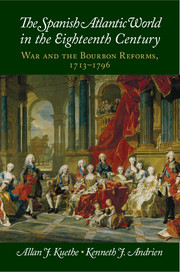Book contents
- Frontmatter
- Contents
- Introduction: War and Reform in Spain and Its Atlantic Empire
- I Alberoni, Patiño, and the Beginnings of Atlantic Reform, 1713–1736
- II The Second Wave of Reform, 1736–1763
- III Pinnacle of the Bourbon Reforms, 1763–1796
- 7 The First Phase of Reform under Charles III, 1763–1767
- 8 The Reorganization of Spain’s Atlantic Empire, 1767–1783
- 9 Adjustments and Refinements in the Reformist Agenda, 1783–1796
- Conclusion: War and Reform in the Spanish Atlantic World
- Timeline for the Spanish Atlantic World in the Eighteenth Century
- Bibliography
- Index
- Plate section
- References
8 - The Reorganization of Spain’s Atlantic Empire, 1767–1783
Published online by Cambridge University Press: 05 June 2014
- Frontmatter
- Contents
- Introduction: War and Reform in Spain and Its Atlantic Empire
- I Alberoni, Patiño, and the Beginnings of Atlantic Reform, 1713–1736
- II The Second Wave of Reform, 1736–1763
- III Pinnacle of the Bourbon Reforms, 1763–1796
- 7 The First Phase of Reform under Charles III, 1763–1767
- 8 The Reorganization of Spain’s Atlantic Empire, 1767–1783
- 9 Adjustments and Refinements in the Reformist Agenda, 1783–1796
- Conclusion: War and Reform in the Spanish Atlantic World
- Timeline for the Spanish Atlantic World in the Eighteenth Century
- Bibliography
- Index
- Plate section
- References
Summary
Despite suffering setbacks with the loss of Havana and the motín of Esquilache, the reign of Charles III would mark the pinnacle of colonial reorganization and the resurgence of Spanish military power in the Atlantic world. The pace and character of reform varied during Charles’s rule, influenced by the nature of the challenges Spain faced, the opportunities for change, the power of vested interests in Spain and the Indies, pressures from rival powers, the character of the king’s ministers, and the level of commitment and enthusiasm of Charles himself. Following the Seven Years’ War, the king and his Sicilian de facto prime minister, the Marqués de Esquilache, pushed a reformist agenda aggressively, but the pace faded after the popular unrest in March 1766, which led to the Italian’s ouster. The opportunity for revenge offered by the colonial rebellion against Great Britain in North America opened the door to a renewal of a reformist agenda under José de Gálvez. Despite the uneven results of the Gálvez reforms, Spain would register military advances both on land and at sea, scoring a telling series of victories against Great Britain in the War of the American Revolution.
Charles was the most ambitious and capable of the Bourbon monarchs. A proponent of the liberating ideals of the Enlightenment, he brought a freshness of mind to the throne, enabling him to challenge entrenched partisan groups and experiment boldly in search of realistic alternatives to modernize Spain and its empire. The policies he pursued were typical of the European enlightened absolutism of his time, which championed both reform from above and the use of human reason to attain progress. Charles sought to curtail the power of a conservative aristocracy and of the various privileged groups opposed to reform in both Spain and the Indies. Although a pious man, he also curbed the temporal power of a reactionary clergy and expelled the ultramontane Jesuit order. Championing efficient government, Charles centralized and rationalized royal administration, codified laws, and tightened tax collection. To promote economic development, he constructed roads, colonized frontiers, and fostered native industry, principally through state enterprise. He supported science, built a reservoir, and created a modern banking system. He also beautified Madrid, embracing architectural good sense and elegant interior design. Most importantly, he infused new energy into the challenge of colonial reform, which the crown had addressed so unevenly over the preceding decades.
- Type
- Chapter
- Information
- The Spanish Atlantic World in the Eighteenth CenturyWar and the Bourbon Reforms, 1713–1796, pp. 271 - 304Publisher: Cambridge University PressPrint publication year: 2014

